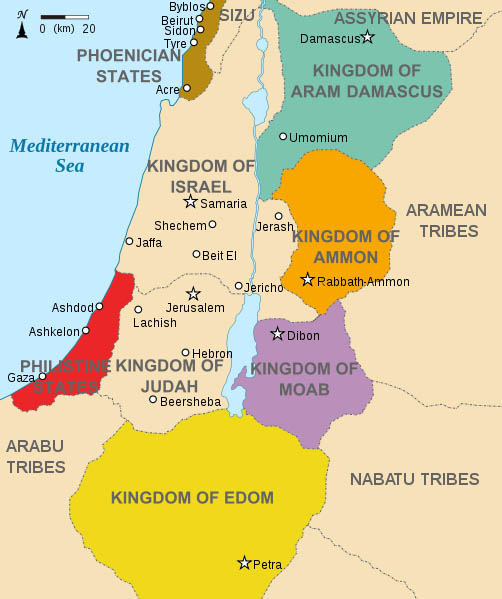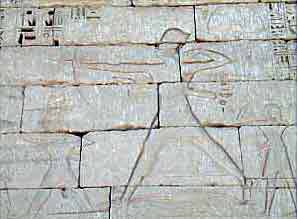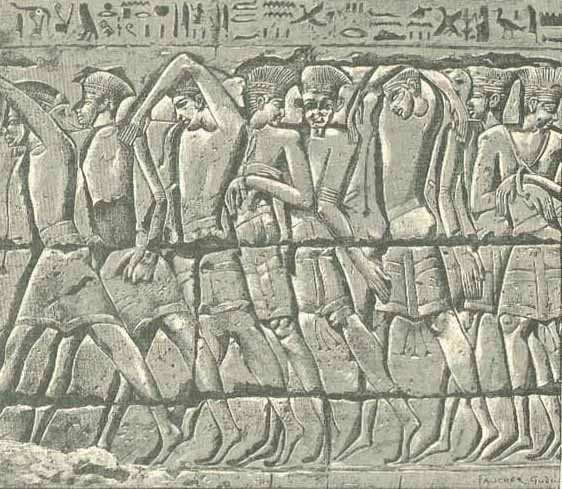

The historic Philistines were an Indo-European people who appeared in the southern coastal area of Canaan at the beginning of the Iron Age (circa 1175 BC), most probably from the Aegean region. According to the Bible, they ruled the five city-states (the "Philistine Pentapolis") of Gaza, Askelon, Ashdod, Ekron and Gath, from the Wadi Gaza in the south to the Yarqon River in the north, but with no fixed border to the east. The Bible paints them as the Kingdom of Israel's most dangerous enemy. Originating somewhere in the Aegean their population was around 25,000 in the 12th century BC, rising to a peak of 30,000 in the 11th century BC, of which the Aegean element was not more than half the total, and perhaps much less.
1475 BC: Thutmose III conquers Canaan; beginning of Egyptian domination of southern Canaanite plain.
-
1175 BC: Ramses III defeats the Sea Peoples including Philistines and settles captives in fortresses in southern Canaan. Papyrus Harris I gives a brief description of the outcome of the battles and the fate of the Sea Peoples. Ramesses III tells us that, having brought the imprisoned Sea Peoples to Egypt, he placed them in strongholds.

Ramses III defeating the Sea People

-
1150 BC: final Egyptian withdrawal from southern Canaan.
10th-7th centuries BC: Philistines lose most of their distinctive culture and absorb that of surrounding peoples.

Philistines on the Egyptian Temple at Medinet Habu

The Hittite and Mycenaean cultures collapsed at the same time, and various people from that area invaded Egypt, where they were called the Sea Peoples - the Philistines, the Lycians, and the Achaeans, among others (possibly the Trojans). Egypt defeated Sea Peoples off, but collapsed soon after.
It has been suggested that the Philistines formed part of the great naval confederacy, the "Sea Peoples", who had wandered, at the beginning of the 12th century BCE, from their homeland in southern Greece and the Aegean islands to the shores of the Mediterranean and repeatedly attacked Egypt during the later Nineteenth Dynasty. Though eventually repulsed by Ramesses III, he was, according to the theory, apparently unable to dislodge them from their settlements in Canaan.
Sea Peoples is the term used for a mysterious confederacy of ship-faring raiders who sailed into the eastern shores of the Mediterranean, invaded Cyprus, Hatti and the Levant, and attempted to enter Egyptian territory during the late 19th dynasty, and especially year 5 of Rameses III of the 20th Dynasty. The term "Sea Peoples" was never used in Egyptian records, but has been popularized in the last century.
The earliest mention of the Sea Peoples proper is in an inscription of the Egyptian king Merneptah, whose rule is usually dated from 1213 BC to 1204 BC, although mention of individual groups does occur earlier (for example Denyen, during the reign of Amenhotep III and Shardana, as mercenaries to Rameses II. Merneptah states that in the fifth year of his reign (1208 BC) he defeated an invasion of an allied force of Libyans and the Sea People, killing 6,000 soldiers and taking 9,000 prisoners.
About 20 years later the Egyptian king Ramses III was forced to deal with another invasion of the Sea Peoples, this time allied with the Philistines. In the mortuary temple he built in Thebes, Ramses describes how, despite the fact "no land could stand before" the forces of the Sea People and that they swept through "Hatti, Kode, Carchemish, Arzawa, and Alashiya" destroying their cities, he defeated them in a sea battle. He gives the names of the tribes of the Sea People as including: the Peleset, the Tjeker, the Shekelesh, the Denyen, and the Weshesh. However, because this list is identical to the one Merneptah included in his victory inscription, and because Ramses also describes several fictitious victories on his temple walls, some Egyptologists believe that he never actually fought the Sea Peoples, but only claimed the victories of Merneptah as his own - a common practice of a number of the Pharaohs.
A Sea People appear in another set of records dated around the early 12th century BC. Ammurapi, the last king of Ugarit (c.1191 BC - 1182 BC) received a letter from the Hittite king Suppliluliuma II warning him about the "Shikalayu who live on boats" who are perhaps the same people as the Shekelesh mentioned in Merneptah's list. It may be relevant that shortly after he received this communication, Ammurapi was overthrown and the city of Ugarit sacked, never to be inhabited again.
The abrupt end of several civilizations in the decades traditionally dated around 1200 BC have caused many ancient historians to hypothesize that the Sea People caused the collapse of the Hittite, Mycenaean and Mitanni kingdoms. However, Marc Van De Mieroop and others have argued against this theory on several points. Grimal argues that the kingdoms of the Mittani, Assyria, and Babylon were more likely destroyed by a group who dwelled on the edges of the settled lands called by the Akkadian word Habiru.
Another argument Grimal makes is that the attempted Sea People invasion of Egypt that Ramses III foiled is now seen as nothing more than a minor skirmish, the records of his victories on his temple walls being greatly exaggerated. Though it is clear from the archeological excavations that Ugarit, Ashkelon and Hazor were destroyed about this time, Carchemish was not and other cities in the area such as Byblos and Sidon survived unscathed.
Another hypothesis concerning the Sea People, based on their recorded names, is that they may have been formed of people involved in the Greek migrations of this period, either the Greek-speaking invaders (identifying the "Ekwesh" with the Achaeans and the "Denyen" with the Dananoi, an ancient name for the Greek people).
This theory implies that the Philistines were part of this Greek-speaking confederacy. This theory was recently revived by the archeologist Eberhard Zangger in 2001 (earlier in German) that the Sea Peoples were the early semi-literate city states of the Greek Mycenaean civilizations, who destroyed each other in a disastrous series of conflicts lasting several decades.
There would have been few or no external invaders and just a few excursions outside the Greek speaking part of the Aegean civilization. The city states were semi-literate in the sense that very few individuals could master the complex syllabary used to write Linear B and other written forms of the early Greek language, and, thus, relatively few documents were produced in daily life to bear witness to the fratricidal nature of the wars.
In contrast, the completely alphabetic writing system which started to appear with the rise of Ancient Greece around 800 BC was relatively easy to learn and use, thus giving rise to the production of many documents, both fictional and non-fictional.
In contradistinction to the foregoing interpretation of relevant textual records, the archaeological record provides a substantial basis to believe that peoples from central Europe and the Italian peninsula may have contributed to the Sea Peoples phenomenon.
Pottery and bronze weapons of a distinctly Italic type have been found in quantity at excavations of structures built atop the charred ruins of cities believed to have been burnt to the ground by the Sea Peoples. Attempts have been made to identify certain Sea Peoples with Italian peoples; for example, some scholars have speculated that the Shekelesh can be identified with the ancient people of Sicily.
Additionally, brooches of a plainly Central European type, and amber beads, have also been found at some of the sites. None of these items appear in the archaeological record of the area prior to the Sea Peoples period. Also worth noting is that some of the knives and cups of an Italic design bear a strong resemblance to knives and cups unearthed in Hungary and central Germany, dating to the period 1800 - 1600 BC.
One thing about the Sea Peoples is beyond doubt: following violent conquest, the Sea Peoples always burnt rich cities to the ground. They made no attempt to retain this wealth, but instead built new settlements of a lower cultural and economic level atop the ruins. This demonstrates a deep scorn and contempt for what these cities represented. It is unlikely that the traditional Helladic warrior classes would have so discarded the spoils of victory, if the writings of Homer are to be considered a guide.
A recent theory proposed by Holst and others is that the Sea Peoples, facing starvation, migrated from the Black Sea, in cooperation with the Phoenicians, seeking food and land upon which to settle. An interesting fact supporting this theory is that the Phoenicians alone were spared attack from the Sea Peoples.
Textual and archaeological records show that Greek and Egyptian state structures utilized mercenaries from the north and west. It is possible that these mercenary groups eventually allied themselves with indigenous slave classes to bring down a number of complex but ossified state structures in Greece and the Near East.Some scholars have tenuously identified the Tribe of Dan with the Danua or Denyen, one of the Sea Peoples, speculating that the Danites abandoned the Sea People confederacy and joined the Israelite tribal confederacy sometime during the twelfth century BC. Such an identification would explain the special enmity between the Danites and the Philistines found in the Book of Judges.
Curiously, and in contrast to most theories of their origin, the Egyptians depicted them as being circumcised, and having semitic names. As a consequence, more radical, and less accepted, theories of their origin have been proposed, suggesting that the Sea Peoples represent a group of people from Canaan. In these theories, the group of 5 sea peoples mentioned together are identified as the 5 groups with coastal lands during the era of Solomon:
The Peleset are the Philistines (the name Philistine being a phonetic corruption of Peleset+-ine)
The Danua are the Tribe of Dan
The Shekelesh are the Tribe of Issachar (Shekelesh being understood to translate as men of Sheker, a corruption of men of Sachar)
The Weshesh are the Tribe of Asher (technically the name is equivalent to Uashesh, and so in the theories is a corruption of Asher)
The Tjekker are the Tribe of Manassah (an Egyptian tale Wenamun explicitely mentions that Dor is a Tjekker town, and Dor is the name of a place in the Manassah region)